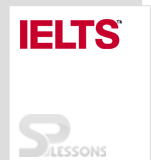 Introduction
Introduction
ILETS Test aspirants are need to face all four language skills – listening, reading, writing and speaking unless you have an exemption due to a disability (see the section on special requirements). Everyone takes the same Listening and Speaking tests. There are different Reading and Writing tests for IELTS Academic and General Training.
 Skills
Skills
A wide range of listening skills are assessed, including:
- understanding of main ideas
- understanding of specific factual information
- recognizing opinions, attitudes, and purpose of a speaker
- following the development of an argument.
 Score Ranges
Score Ranges
Each score represents the applicant's ability for each of the four test sections: reading, writing, speaking, and listening. The scores range from 0 – did not attempt the test to 9 – expert ability. The following
bullets list what each score represents.
- 0 – Did not attempt the test
- 1 – Non-user
- 2 – Intermittent user
- 3 – Extremely, limited user
- 4 - Limited user
- 5 – Modest user
- 6 – Competent user
- 7 – Good user
- 8 – Very good user
- 9 – Expert user
Did You Know?
To gain acceptance to a university, an applicant should strive to get a score of at least 6 on each of the four tests.
An applicant's overall score is the average of the applicant's four test scores. For example, if an applicant receives the following scores, Reading – 8, Writing – 7, Speaking – 7, and Listening – 8, the applicant's overall score is 7.5 (8 + 7 + 7 + 8 = 30. 30/4 = 7.5.) If the applicant's overall score ends in .25, the score rounds up to .50. For example, if an applicant's overall score is 7.25, it rounds up to 7.5.
If the applicant's overall score is 7.75, the score rounds up to the next whole number. For example, if the applicant's overall score is 7.75, it rounds up to 8.0.
1. 40 out 0f 40 – 9
2. 35 out of 40 – 8
3. 30 out of 40 – 7
4. 23 out of 40 – 6
5. 16 out of 40 – 5
 Tips
Tips
Each recording in the Listening test is heard once only.
- You will be given time to read through the questions before you listen.
- As you listen, write your answers on the question paper. At the end of the test, you will have 10 minutes to transfer your answers to the answer sheet. It is essential that you transfer your answers to the answer sheet as nothing you write on the question paper will be marked.
- You must write your answers in pencil.
- An example of a completed Listening answer sheet is given on the next page.
- ‘Completion’ question types (e.g. note completion):
- Pay attention to the word limit. For example, if you are asked to complete a sentence using NO MORE THAN TWO WORDS, and the correct answer is ‘leather coat’, the answer ‘coat made of leather’ would be incorrect.
- Transfer only the missing word(s) to the answer sheet. For example, if you have to complete the note ‘in the ... ’, and the correct answer is ‘morning’, the– answer ‘in the morning’ would be incorrect.
- You will hear the word(s) you need to use in the recording–. You will not need to change the form of the word(s) you hear.
- Pay attention to spelling and grammar: you will lose marks fotakes.
- You may write your answers in lower case or in capitals.




